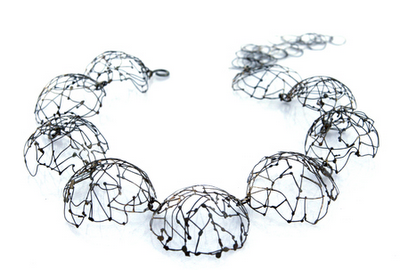 Karen Gilbert doesn’t consider herself a chain-maker in the traditional sense, even though she has been obsessed with exploring the creative potential of links since she began making jewelry.
Karen Gilbert doesn’t consider herself a chain-maker in the traditional sense, even though she has been obsessed with exploring the creative potential of links since she began making jewelry.
She doesn’t use the word “chain-maker,” she says, because it implies that she knows the basic types and techniques of that historical category and she purposefully avoids just that.
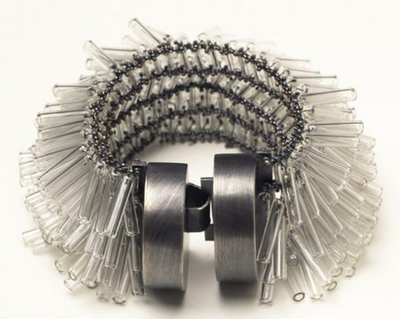 “I’m not technique-driven,” Gilbert says. “I like to learn skills then forget them and play around as much as possible to see where it takes me. I try not to look at other people’s work too much.”
“I’m not technique-driven,” Gilbert says. “I like to learn skills then forget them and play around as much as possible to see where it takes me. I try not to look at other people’s work too much.”
After studying for a while at the California College of Arts & Crafts, she moved to Seattle and began dabbling in “a little of everything”—including stone-cutting, glass- and jewelry-making. Soon after settling on jewelry, she made an elaborate sculptural pendant and put a manufactured chain on it.
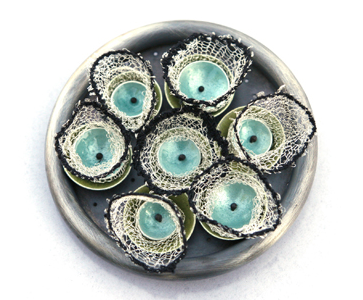 “It drove me nuts,” she recalls. “My work tends to be very loose so the extreme mechanical forms of the machine-made chains didn’t look right. Some designers can pull it off better than others but for me it didn’t work. The contrast between handmade and manufactured elements was very obvious.”
“It drove me nuts,” she recalls. “My work tends to be very loose so the extreme mechanical forms of the machine-made chains didn’t look right. Some designers can pull it off better than others but for me it didn’t work. The contrast between handmade and manufactured elements was very obvious.”

As her designs evolved, ironically, manufactured chains became an integral part. But in Gilbert’s work, you can’t see the chain itself, it serves merely as an armature. “The chains are my structure. I buy them then take them as far as I can. I weave them together, fuse them, I cut them into parts, I put wires through every hole I can possibly find, exploring the minuteness of the chain.”
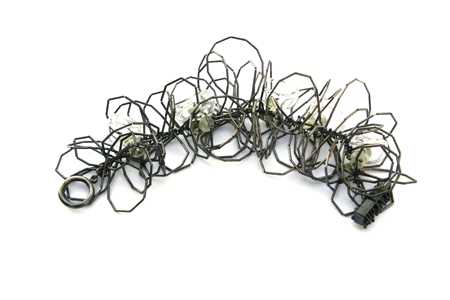
The results are without a doubt chain-like but more like a molecular chain or microorganism viewed through a microscope, growths and filaments exposed.
Gilbert’s primary process is not building links but trapping things in links. She chooses chains with very specific patterns, then using very thin sterling silver wire, loops it through the links, then beads one or both ends in order to trap it. Sometimes she forms a jump ring around the links. The over-riding principal is that “nothing is really attached.”
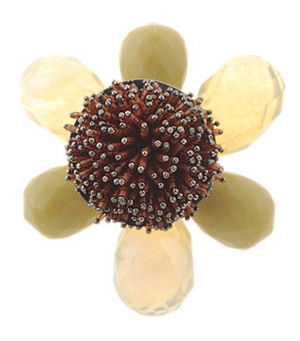 Some of her necklaces and bracelets resemble that furry yarn college students knit into scarves. Others are more compact, more beaded. But all look vaguely familiar.
Some of her necklaces and bracelets resemble that furry yarn college students knit into scarves. Others are more compact, more beaded. But all look vaguely familiar.
“I’m very interested in microbiology, all these minute things in our world that we don’t even see. I’m making forms and creatures that don’t exist in our consciousness but are everywhere. So when you look at it, you recognize it but don’t know why.
“We’re built of little organisms and cell structures. That’s who we are. We have an inherent knowledge of these things but we can’t pinpoint why it’s familiar.”
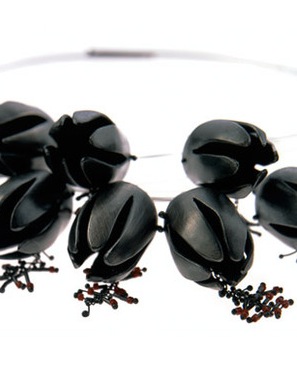 The only text Gilbert relies on for inspiration is a collection of vintage science books from the 20s and 30s. “They were published before photos were used in science books. They’re full of old etchings of plant life. I look at those if I’m struggling with a piece, wondering if it’s working aesthetically or trying to figure out how to finish it.
The only text Gilbert relies on for inspiration is a collection of vintage science books from the 20s and 30s. “They were published before photos were used in science books. They’re full of old etchings of plant life. I look at those if I’m struggling with a piece, wondering if it’s working aesthetically or trying to figure out how to finish it.
“If you go to nature and science, everything works perfectly. It has all the answers. What’s pleasing to our eyes is in science.”
Gilbert was once invited to teach a workshop to a group of traditional chain-makers. “I was brought in as the inspirational art workshop,” she says. “I talked about fusing, melting and trapping. People were blown away by the idea that you don’t have to follow the rules.”
You’ll find plenty more of her amazing jewelry and some sculpture too on her web site.
Related posts:
Pierre-Yves Paquette: modern mokume gane
So-Young Park: hammered, soldered abstractions
Chihiro Makio: tea and flowers
Related products:

